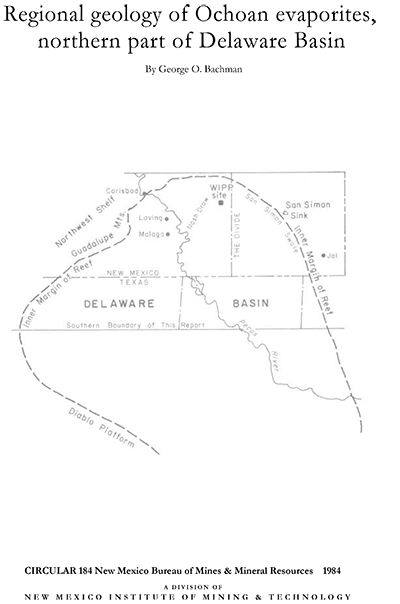
Circular 184—Regional geology of Ochoan evaporties northern part of the Delaware Basin
By G. O. Bachman, 1984, 22 pp., 1 table, 13 figs., 2 sheets.

The evaporites of the Ochoan Series (Permian) are subject to dissolution resulting in karst features analogous to those formed in limestone regions. The Castile Formation, which is the basal unit of the Ochoan Series, underlies the Waste Isolation Pilot Plant (WIPP) site. Because of concern that evaporites in the Castile might be dissolved and the WIPP site might be unsafe, the regional setting of the Castile and its implications are examined in detail. Numerous studies of the Delaware Basin have been undertaken with various objectives. The earliest comprehensive studies were the result of exploration for petroleum. Drill holes penetrated Ochoan and older Permian rocks, providing control points for correlation of stratigraphic units. Potash minerals were discovered east of Carlsbad in 1925. Development of these deposits included extensive drilling programs to determine their extant and grade. As a result of this development, the details of the potash-bearing formations are well understood within the potash mining district in the north-central part of the Delaware Basin.
The Ochoan Series in the northern part of the Delaware Basin, southeastern New Mexico, includes in ascending order the Castile, Salado, and Rustler Formations, and the Dewey Lake Red Beds. The Castile and Salado Formations comprise a sequence of evaporites which include anhydrite, gypsum, halite, and associated potash salts. The Rustler Formation contains some halite and minor amounts of potash minerals. These evaporites were deposited within the basin formed by the Capitan barrier reef, as well as across the reef. The evaporites, as well as the Capitan reef, are all subject to dissolution with resulting karst features analogous to those formed in limestone regions.
An Ancestral Pecos River was the major drainage system in the western part
of the Delaware Basin, New Mexico, during late Cenozoic time. That ancient
river system was responsible for the formation of an extensive karst terrain
along the east side of the present Pecos River in New Mexico and southward
into Texas. During late Cenozoic time extensive dissolution occurred in
the Salado Formation within the karst area as a result of the ground-water
regime. The dissolution front was perched on the upper anhydrite member
of the Castile Formation. On the eastern side of the Delaware Basin in New
Mexico, a large collapse sink-San Simon sink-overlies the Capitan reef which
is a prominent aquifer system in that area. So-called "breccia pipes"
are ancient sinks which have collapsed into the caverns in the reef on the
northern margin of the basin. These have since been partially exhumed. The
San Simon sink is presumed to be a modern analog of these breccia pipes.
$8.00
Buy
Now
Also available as a free download.
Download
| File Name | Size | Last Modified |
|---|---|---|
| Circular-184.pdf | 7.39 MB | 01/11/2021 03:42:01 PM |



